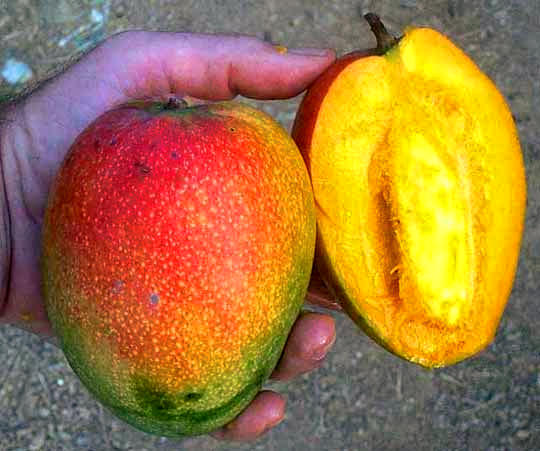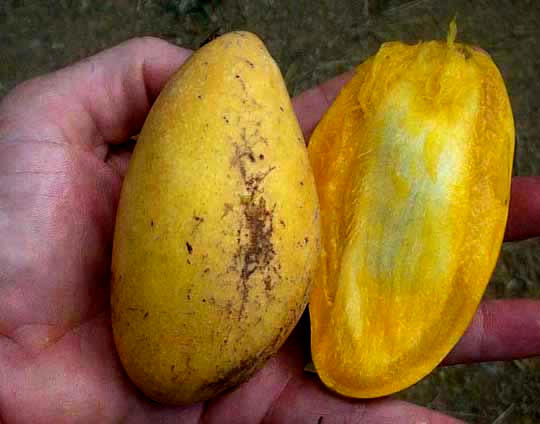Excerpts from Jim Conrad's
Naturalist Newsletter
from the July 20, 2007 Newsletter issued from Sierra Gorda Biosphere Reserve, QUERÉTARO, MÉXICO
MANGOS
I've been waiting for this. For weeks and weeks little green mangos have been dangling from stocky, good-sized trees with dark green, evergreen leaves shaped like giant peach leaves. Slowly, slowly they've been growing. Below, you can see a couple of softball-size fruits currently on a neighbor's tree I pass each day:

Those fruits are still too green, only now beginning to show a hint of burgundy on their topsides. Look how they dangle on foot-long cords, which are what's left of the central axes of big flower-inflorescences. The flowers themselves were tiny, pinkish-white things bearing only a single fertile stamen per blossom and clearly few of the blossoms set fruit. Soon after flowering sometimes you could see several little fruits forming in the same inflorescence, but the weak ones aborted, falling off the tree, leaving the best to develop.
At http://www.fruitlovers.com/mangoposter.jpg you can see a colorful poster showing 143 distinct named mango varieties. The variety names are provided at http://www.fruitlovers.com/mangonames.html.
I just got back from the market with a bagful of mangos and you can see a couple of those below:

I'm told that the ones in the above picture, probably the same kind hanging on our neighbor's trees, are the Kent variety. Notice the big, flattish, white seed in the fruit's center. Nowadays all over town you see these seeds discarded by mango eaters. Before long the furry, sun-bleached seeds will mount up in gutters like so many fast-breeding albino cockroaches.
In the above picture do you see the fibers arising from the seed's edge? Those fibers keep you from biting into a mango the way you would a peach. If you try to eat them peach-like, you'll end up picking fibers from between your teeth. If you cut mango flesh from its seed, then fibers are no issue.
Botanically there's something weird about those seeds. Each seed usually contains several embryos, and any embryo can make a tree. Usually only one of those embryos has resulted from fertilization. All the others are asexual, possessing exactly the same genetic makeup as the mother tree. People who grow mango trees on a large scale know to choose their seeds from superior trees, then destroy the sexual embryo while encouraging an asexual embryo to sprout. You don't want the sexual embryo because you never know what the pollen provider was like. In this way a whole plantation can be populated by genetically identical trees, all from a single superior mother tree. A document in PDF format showing a seed with multiple embryos and much more resides at http://www.agroforestry.net/tti/Mangifera-mango.pdf.
Most people around here say that the smaller Manila variety is better than my Kent. You can see Manilas below:

Nowadays you can buy a bag of six to eight perfect Manilas for about 90 cents US. As more trees ripen the price falls. When the rainy season really gets into gear little white worms will begin appearing in the fruits and the price will drop more. I remember times when I was low on dough but could buy an inordinate number of sublimely sweet mangos, a few jalapeños and a kilo of freshly made, still-hot tortillas, and banquet like a king.
By the way, mangos are the fruits of MANGIFERA INDICA, native to northern India, Burma and Malaya, and are members of the Cashew Family, in which we also find Pistachio, sumacs, and Poison Oak and Poison Ivy! With that pedigree I wouldn't be surprised if some people show an allergic reaction to mangos. Happily, not me.